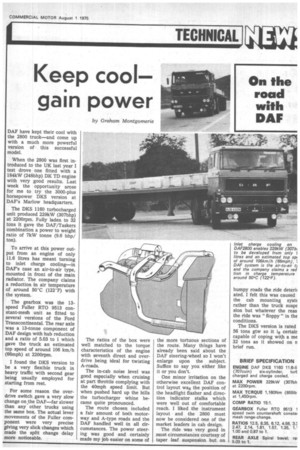Keep cool gain power
Page 21

If you've noticed an error in this article please click here to report it so we can fix it.
by Graham Montgomerie DAF have kept their cool with the 2800 truck—and come up with a much more powerful version of this successful model.
When the 2800 was first introduced to the UK last year I test drove one fitted with a 184kW (248bhp) DK TD engine with very good results. Last week the opportunity arose for me to try the 3000-plus horsepower DKS version at DAF's Marlow headquarters.
The DKS 1160 turbocharged unit produced 229kW (307bhp) at 2200rpm. Fully laden to 32 tons it gave the DAF/Taskers combination a power to weight ratio of 7kW tonne (9.6 bhp/ ton).
To arrive at this power output from an engine of only 11.6 litres has meant turning to inlet charge cooling—in DAF's case an air-to-air type, mounted in front of the main radiator. The company claims a reduction in air temperature of around 50'C (122°F) with the system.
The gearbox was the 13speed Fuller RTO 9513 constant-mesh unit as fitted to several versions of the Ford Transcontinental. The rear axle was a 134onne component of DAF design with hub reduction and a ratio of 5.03 to 1 which gave the truck an estimated top speed of around 106 km/h (66mph) at 2200rpm.
I found the DKS version to be a very flexible truck in heavy traffic with second gear being usually employed for starting from rest.
For some reason the overdrive switch gave a very slow change on the DAF—far slower than any other trucks using the same box, The actual lever movements of the Fuller component were very precise giving very slick changes which made the split change delay more noticeable. The ratios of the box were well matched to the torque characteristics of the engine with seventh direct and overdrive being ideal for twisting A-roads.
The in-cab noise level was good especially when cruising at part throttle complying with the 40mph speed limit. But when pushed hard up the hills the turbocharger whine became quite pronounced.
The route chosen included a fair amount of both motorway and A-type roads and the DAF handled well in all circumstances. The power steering was good and certainly made my job easier on some of the more tortuous sections of the route. Many things have already been said about the DAF steering-wheel so I won't enlarge upon the subject. Suffice to say you either like it or you don't.
One minor irritation on the otherwise excellent DAF control layout was the position of the headlight flasher and direction indicator stalks which were well out of comfortable reach. I liked the instrument layout and the 2800 must now be considered one of the market leaders in cab design.
The ride was very good in most circumstances courtesy of taper leaf suspension but on bumpy roads the ride deterii ated. I felt this was caused the cab mounting syste rather than the truck suspe sion but whatever the reas the ride was " floppy " in the conditions.
The DKS version is rated 56 tons gtw so it is certair capable of coping with a me 32 tons as it showed on T1 brief run.
BRIEF SPECIFICATION
ENGINE DAF DKS 1160 11.6-11 (707cuin) six-cylinder, turt charged and charge cooled.
MAX POWER 229kW (307bh at 2200rpm.
MAX TCRQUE 1,160Nm (855Ib at 1,450rpm.
COMP RATIO 15:1.
GEARBOX Fuller RTO 9513 1 speed twin countershaft constat mesh range-change.
RATIOS 12.5, 8.35, 6.12, 4.56, 3.:: 2.47, 2.14, 1.81, 1.57, 1.35, 1.00 and 0.87 to 1.
REAR AXLE Spiral bevel; ra. 5.03 to 1.




















































































